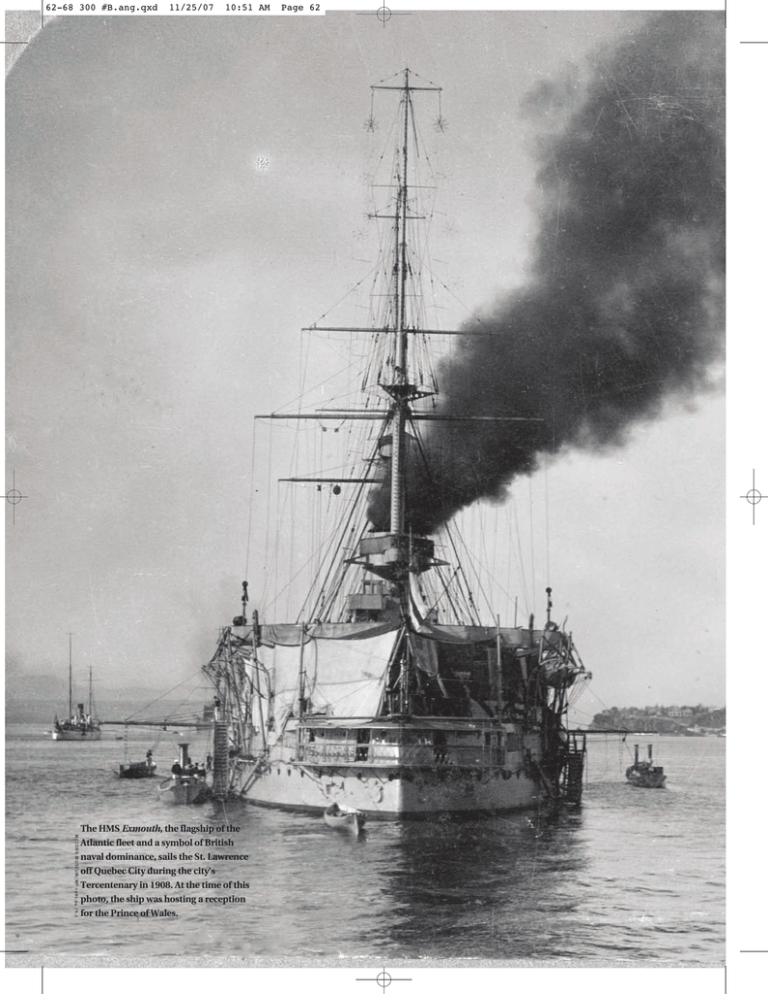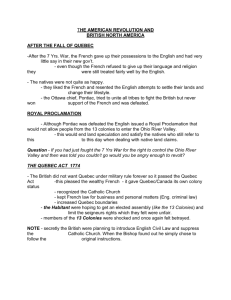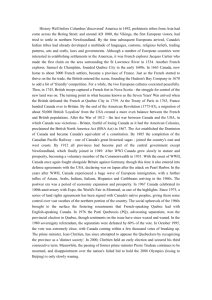Exmouth Atlantic fleet and a symbol of British
advertisement

62-68 300 #B.ang.qxd 11/25/07 10:51 AM MCCORD MUSEUM/MP-1981.94.76.1 The HMS Exmouth, the flagship of the Atlantic fleet and a symbol of British naval dominance, sails the St. Lawrence off Quebec City during the city’s Tercentenary in 1908. At the time of this photo, the ship was hosting a reception for the Prince of Wales. Page 62 62-68 300 #B.ang.qxd 11/25/07 10:51 AM Page 63 Lord Grey, governor general of Canada, circa 1905. One Big Happy Empire MCCORD MUSEUM/II-154038.1 Lord Grey hoped to turn the 300th anniversary of Champlain’s founding of Quebec into a grand show of British imperialism. by Peter Black 62-68 300 #B.ang.qxd Above: Actors dressed in period costumes re-enact the 1608 arrival of Samuel de Champlain aboard his ship, the Don de Dieu, during the Quebec Tercentenary celebrations. Below: In this panoramic 1908 photograph, ships of the powerful British fleet parade past Quebec City in a show of military might during the city’s 300th 11/25/07 10:51 AM Page 64 I t was a sparkling day in July 1908 and the festive crowd gathered on the banks of the St. Lawrence River for Quebec City’s spectacular tercentenary celebrations was witnessing a remarkable, if somewhat unsettling, scene. Drifting towards shore was a scaled-down replica of Samuel de Champlain’s ship, Don de Dieu, accompanied by canoes full of authentic natives. Striking a pose on deck — and central to this historic re-enactment — was “Champlain,” portrayed by Charles Langelier — a former federal and provincial cabinet minister and good friend of Prime Minister Wilfrid Laurier — dressed in breeches, doublet, wig, and goatee. As compelling as this scene would have been, spectators may well have been distracted by what was looming in the background. For, moored in the river between Quebec City and Lévis were some of the mightiest seagoing war machines ever created by the British Navy. It was a show of military force the likes of which had not been seen in the St. Lawrence since General James Wolfe’s invading fleet penetrated the river almost 150 years earlier. anniversary celebrations. 64 February - March 2008 The Beaver In all, eight British ships of the line had assembled in the river, including the HMS Indomitable, the brand new battleship launched but weeks earlier and dubbed “The Mysterious” by navy watchers because of the secrecy surrounding her construction in this age of arms buildup. It was Indomitable that had brought the Prince of Wales — a navy man who in two years would become King George V — to Quebec for the festivities. Combined with two modern French vessels and an American battleship (aboard which came U.S. Vice-President Charles Fairbanks), the flotilla in the St. Lawrence formed a backdrop of impressive belligerent power throughout the tercentenary. To some observers, the contrast between Champlain’s mock wooden ship and the display of modern steel-clad British naval muscle illustrated eloquently the contradictions underpinning what began as a celebration of three centuries of survival by Champlain’s Nouvelle France inheritors. Quebec City's stupendous 300th birthday party has been largely forgotten and scant public evidence of the event remains today, save for a small plaque on the Plains of Abraham. Still, the question of how John Bull managed 62-68 300 #B.ang.qxd 11/25/07 10:51 AM Page 65 COLLECTION OF H.V. NELLES BIBLIOTHEQUE ET ARCHIVES NATIONALES DU QUEBEC to crash Sam Champlain’s fete persists. Indeed, two relatively recent books have probed the event. H.V. Nelles (The Art of Nation-building: Pageantry and Spectacle at Quebec’s Tercentenary, 1999) and Ronald Rudin (Founding Fathers: The Celebration of Champlain and Laval in the Streets of Quebec, 1878-1908, 2003) examine in depth the politics behind this extraordinary celebration. One figure emerges from these and other reflections as the driving force behind the form the tercentenary would eventually take. That instigator was none other than Governor General Earl Grey, the man most Canadians know as the donor of the Canadian Football League’s championship trophy. With Lord Grey calling the plays, Quebec’s tercentenary became an event of unprecedented grandeur, but also of potentially explosive political controversy. Planning for a 300th anniversary party began innocently enough. The genesis of the idea came from HonoréJulien-Jean-Baptiste Chouinard, the clerk for the city of Quebec. Chouinard, an amateur historian, wrote an editorial in December 1904 in which he called for an event in 1908 to mark Champlain’s founding of the colony. The event would include not only historical celebrations, but also a surge of municipal improvements to restore some of the city’s historic features, especially the Plains of Abraham. Chouinard’s appeal for a Champlain celebration was quickly taken up by the local Saint Jean Baptiste Society (SJBS), which was already planning festivities in 1908 for the unveiling of a monument to Bishop Laval, the religious father of Quebec. With energetic young Quebec City Mayor George Garneau at the helm, a delegation met Sir Wilfrid Laurier in Ottawa late in 1906 to make the case for major federal support. The prime minister was interested, but having battled bishops and bleus (Quebec Conservatives) all his political life, he was wary that such a bash might provoke Quebec nationalists if handled the wrong way. Laurier would have preferred to hold off until 1909, when the Quebec Bridge then under construction was set to be completed. (When it collapsed in late August 1907, killing 75 workers, Laurier tried to use the disaster as an ARCHIVES DE LA VILLE DE QUEBEC excuse to delay the Champlain festivities.) Nevertheless, Laurier made a tentative pledge of federal funding, which was enough to spur local authorities to form committees and begin planning. Meanwhile, the imperialist dynamo Earl Grey was forming his own vision of what would be celebrated at Quebec’s 300th anniversary. Albert Henry George Grey, son of a top Buckingham Palace advisor, had been sworn in as governor general of Canada in December 1904. Grey landed in Canada imbued with a mission to promote the British Empire and, as a key component of that mission, to lobby the Laurier government to commit itself to building a navy to bolster the British fleet. This was sensitive territory in Quebec, where nationalists were still on edge over Canada’s Boer War involvement. The issue had split Canada along English-French lines and prompted Laurier's deathless quote: “The province of Quebec does not have opinions; it has only sentiments.” Grey, according to Nelles, recognized that he needed to change French Canadian attitudes first, and that “emotional and symbolic issues of nation and empire would do more for imperial unity than a dreadnought and, if successful, might in due course produce a dreadnought as well.” The new GG arrived at a time when the Treaty of Washington between Britain and the United States (1871), and the Entente Cordiale between Britain and France (1904), had created a powerful North Atlantic alliance in which Canada was a cornerstone. In this context, Grey quickly seized on a project that would in one stroke promote the British Empire, fortify the Atlantic alliance, stir an emotional attachment to the Empire on the part of French Canadians, and nurture a more assertive, unified Canada. The key was Quebec City. Grey, who spoke excellent French, was smitten with la Vieille Capitale on his first visit, but at the same time was appalled at the condition of some of its precious historical features, particularly the Plains of Abraham, one of the most hallowed grounds in the British Empire. Development pressure and civic paralysis had brought the fields to a critical state. Though the federal government, at the urging of the Literary and His- Above: George Garneau mayor of Quebec, 1906 to 1910. Below: Honoré-JulienJean-Baptiste Chouinard, the clerk for the city of Quebec. Chouinard, an amateur historian, wrote an editorial in December 1904 in which he called for an event in 1908 to mark Champlain’s founding of the colony. LIBRARY AND ARCHIVES CANADA PA PA165609 62-68 300 #B.ang.qxd Prime Minister Wilfrid Laurier and his group arrive for the military revue for the celebration of the 300th anniversary of Quebec. 11/25/07 10:51 AM Page 66 some bridge-building with the Canadiens for whom Wolfe’s September 1759 victory was a bit of a sore point. The governor general, therefore, proposed that the site of the April 1760 Battle of Ste. Foy become an integral part of the future Battlefields Park. In that encounter, the French army rallied after the fall defeat and sent the British scurrying behind the walls of the battered city. The local SJBS had already erected (in 1863) the imposing Monument des Braves statue on the Ste. Foy site. So enthused was Grey by the enormity of the opportunity the Champlain tercentenary project offered to boost the Empire and seduce French Canadians, he pledged to Laurier that he would personally conduct a huge fundraising campaign. Grey, however, had vastly overestimated enthusiasm for the scheme and his financing plan fell embarrassingly short (adieu Goddess of Peace). Clearly, the federal government needed to step in to salvage the situation. torical Society of Quebec, had recently acquired a modest chunk of the property from the profit-savvy Ursuline nuns, a major effort was needed to preserve the Plains from being swallowed whole by urban and industrial encroachment. (Laurier himself was an offender, his government having established the Ross Rifle factory on the Plains in 1902.) Grey decided to lead the charge to transform the Plains into a spectacular monument to the glory of the British Empire and its noble fruit, the nation of Canada, formed from two habitually warring races now united in peace. What better way, then, to celebrate that achievement than to capitalize on the upcoming anniversary of the founding of Quebec, which was also the anniversary of the founding of Canada? Grey elaborated a plan that included the creation of a huge urban historic park, a national museum, and, most spectacular of all, an enormous statue he called the Goddess of Peace. The Goddess would be erected high on the Plains promontory and would stand taller than the Statue of Liberty, replacing the ominous jail parked starkly alone on the site. In Grey’s vision the Goddess would be “the first point of Quebec visible to vessels coming from across the seas (and) offer to the immigrant a welcome more worthy of Canada than that which is now conveyed by the horrible suggestion that Canada’s gift to him is a chance of becoming a prisoner in Abraham's bosom.” Grey’s other plans for “Abraham’s bosom” included U MCCORD MUSEUM/MP-1981.94.41.1 p until nearly the last minute, Laurier had been playing his tercentenary cards close to his waistcoat, and driving Grey and Mayor Garneau nearly mad with frustration. Indeed, Laurier did not fully commit the federal government to the financing and necessary legislation for the park and tercentenary until just six months before the July 1908 event was supposed to be staged. At that point, preparations for the enormous, elaborate, twelve-day celebration revved up, with Grey working feverishly to assure British interests would be centre stage. As the event took form, critics were beginning to sense Champlain was taking a second seat to General Wolfe, sparking, in Laurier biographer Joseph Schull’s description, “sour undercurrents of gaucheries and resentments.” For months, a small but influential conservative Catholic newspaper had been heaping scorn on plans for the festivities. La Verité dedicated itself, as cited by Nelles, to “unmask the game of the imperialists” which would see “Champlain evicted and Wolfe dominate.” Whipped up by a militant Catholic youth organization, grassroots opposition grew to the point where Mayor Garneau and Langelier were compelled to attend public meetings and reassure people that Champlain would be the leading man in the show and that average Frenchspeaking citizens of Quebec would be included in celebrations. (As it turned out, on the eve of the tercentenary’s official opening, the same Catholic youth group staged a large demonstration at the foot of the Champlain statue to deliver a strongly pro-Champlain, pro-Catholic message. Most political officials stayed away.) This church-fuelled youthful nationalism threatened to undermine popular support for the event and exacerbate Laurier’s mounting political problems on the home front. Grey noted Laurier’s concern that “the priests are heading in a direction (that will) eventually lead to another abortive Papineau trouble,” referring darkly to the Rebellions of 1837-38. The governor general, however, according to Nelles, “deluded himself that the tercente- 62-68 300 #B.ang.qxd 11/25/07 10:51 AM Page 67 MCCORD MUSEUM/MP-1981.94.45.2 nary celebration might help liberate Quebec from the iron grip of ultramontane reaction.” Laurier’s nemesis, the Quebec nationalist hero Henri Bourassa, wrote this assessment, before skipping off to Europe to avoid the tercentenary: “In my soul, there is not a shadow of a doubt, knowing Earl Grey as I have learned to know him in Ottawa, that he decided from the beginning to transform the celebration of the birth of Quebec and of French Canada into a grand historic reminder of the Conquest in order to show his imperialist friends in London that the new imperial religion has made progress among French Canadians.” Regardless of these and other criticisms, for the most part Quebec’s bourgeoisie hopped aboard Earl Grey’s tercentenary bandwagon, bedazzled perhaps by the excitement of being the focus of the world for a fleeting two summer weeks. Even the bishops joined in — though at first they had misgivings about the representation of republican, anti-clerical France in the festivities. Grey succeeded in mollifying the bishops by luring the Duke of Norfolk to Quebec. The Duke was not only the leading lay Catholic fig- ure in Britain, but was known to be pals with the Pope. As it turned out, the convivial duke was a smash with Quebec’s clerical hierarchy. “He takes back with him the hearts of all Catholics in Quebec,” Grey wrote to the Colonial Office. B y virtually all accounts, the tercentenary events were a success on the organizational level. Ronald Rudin concludes that the tercentenary “was the largest commemorative event ever staged in Canada” — and perhaps unequalled until Canada’s centennial celebrations and Expo 67 in Montreal. The statistics themselves are staggering. The little city of seventy thousand hosted (and housed and fed) at least 150,000 visitors, including about twenty thousand sailors and soldiers, plus dignitaries ranging from the mayor of Brouage, Champlain’s hometown, to the governors general of Australia and New Zealand, to descendants of Wolfe and Montcalm. A part of the Plains became a huge 750tent city to handle the overflow from the hotels and inns. Thousands of period costumes were designed and sewn to be worn by the armies of citizen-actors cast to play roles in The Beaver February - March 2008 British troops salute the Prince of Wales during a military review on the Plains of Abraham during the Quebec 300th anniversary celebrations. 67 62-68 300 #B.ang.qxd 11/25/07 10:51 AM Page 68 the five elaborate pageants staged over the course of a week. A ten-thousand-seat temporary grandstand was built for spectators for the big Plains events, which included the pageants, an outdoor mass, and military reviews. There were costumed parades through the streets, an impromptu march by Canada's fledgling military corps, musical concerts of all types, and dozens of balls and banquets in the city or aboard any and all of the ships anchored offshore. Then, of course, there was the Prince of Wales, a homebody who agreed to part with his wife for two weeks at the beseeching of his pal Earl Grey. The prince, also fluent in French, was the undeniable star of the tercentenary, and, as Nelles recounts, Grey was convinced that the “electric thrill” with which the Prince charmed the crowds, “helped to fuse the Canadians of French and British descent into a United People, to consolidate the Dominion, to unite the Empire (and) strengthen the Crown.” If that had been his aim, Grey’s success was not especially long-lasting. Even as the battleships returned to their home ports, Europe was sliding towards war. Whatever fervour the tercentenary may COLLECTION OF H.V. NELLES COLLECTION OF H.V. NELLES Quebec City’s 1908 Tercentenary inspired a mini-industry of arty postcards, souvenir programs, stationary, and other keepsakes. The postcards (above) feature an imagined portrait of Champlain and the view of the St. Lawrence from the Dufferin Terrace in Quebec City. 68 have stirred in French Canadians fizzled in the face of what many influential Quebecers saw as a foolish imperialist adventure. Later, the fizzle would turn to fury with anti-conscription riots. Jules Fournier, a local editorialist, argued at the time that much of Quebec's population had stayed away from the celebrations, “identifying,” in Nelles’ analysis, “a sentiment that would surface much more dramatically a few years later with the outbreak of the First World War. Again on that occasion, while some French Canadians were prepared to support the war effort, large numbers felt no emotional attachment.” The event also presaged a Canadian coming of age that, drenched in blood and sealed with sacrifice, would emerge from the Great War. Historian Laurier Lapierre notes that during the tercentenary Wilfrid Laurier “made good speeches in which there was one prophetic statement: ‘We are reaching the day when the Canadian Parliament will claim coequal rights with the British February - March 2008 The Beaver Parliament, and when the only ties binding us together will be a common flag and a common crown.’ ” Earl Grey’s attempt to hijack the Champlain celebration as an instrument of his imperialist agenda may have backfired in the long run, but no one could deny that for two glorious weeks he had succeeded in putting Quebec and Canada on the map. And, thanks in no small part to Grey’s efforts, Canadians today enjoy one of the most beautiful, historic urban parks on the planet. Grey’s “abominable” Quebec jail building remains to this day on the Plains, but it was restored and eventually incorporated with the museum he had advocated, finally built in 1933. The united complex is called the Musée Nationale des Beaux-Arts du Quebec. In the end, it seems, this was one of the aspects of nationalism that had triumphed over imperialism as a long-term consequence of Quebec's tercentenary. Peter Black is a syndicated columnist and CBC radio producer. He lives in Quebec City. Et Cetera Founding Fathers, The Celebration of Champlain and Laval in the Streets of Quebec, 1878-1908 by Ronald Rudin, University of Toronto Press, Toronto, 2003. The Art of Nation-Building, Pageantry and Spectacle at Quebec's Tercentenary by H.V. Nelles, University of Toronto Press, Toronto, 1999.

![Garneau english[2]](http://s3.studylib.net/store/data/009055680_1-3b43eff1d74ac67cb0b4b7fdc09def98-300x300.png)



